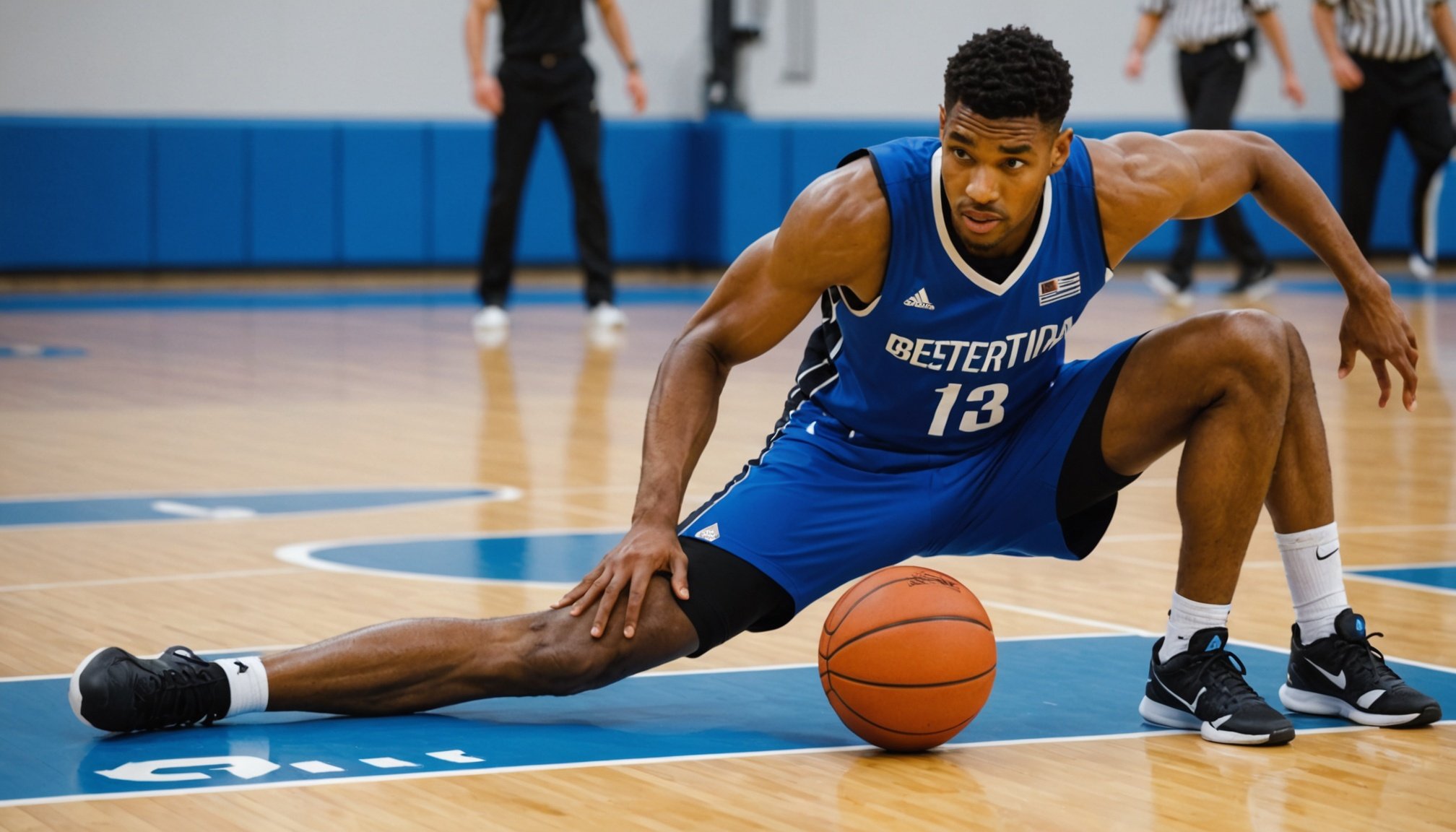Importance of Flexibility in Injury Prevention
In the world of sports, particularly among basketball athletes, flexibility is not just a desirable trait—it’s a critical component of overall athletic performance. Enhanced flexibility benefits players by increasing their range of motion, which contributes significantly to both performance enhancement and injury prevention.
Flexibility allows athletes to move easily and gracefully, reducing the strains and stresses on muscles and joints during high-intensity activities. This, in turn, lowers the risk of injuries, which is a persistent concern in basketball. Statistics show that many injuries in basketball are preventable through improved flexibility. According to a report, athletes with higher flexibility rates encounter fewer sprains and strains compared to their less flexible counterparts.
Also read : Elevate your vertical leap: the ultimate strength training blueprint for basketball athletes in the uk
Experts in sports medicine emphasize that injury prevention is closely tied to maintaining optimal flexibility levels. By incorporating stretching routines and flexibility exercises into their training, basketball athletes can enhance their performance longevity. Not only does this promote a quicker recovery from physically demanding games, but it also ensures the athlete’s career span is extended.
Athletes, coaches, and medical practitioners increasingly acknowledge the profound role of flexibility in reducing injury rates, reinforcing the need for dedicated flexibility training in sports regimens. This proactive approach plays a vital role in safeguarding athletes’ careers and optimizing their performance on the court.
In the same genre : Accelerate your game: proven strategies for uk basketball players to sharpen their offensive first step
Effective Flexibility Strategies for Basketball Athletes
Basketball athletes seek to enhance performance and avoid injuries by improving their flexibility. This section explores dynamic warm-ups, static stretching techniques, and the incorporation of yoga and Pilates.
Dynamic Warm-Ups
Engaging in dynamic warm-ups is essential for basketball athletes. These exercises, such as high knees or arm circles, increase blood flow and prepare the body for training or games. Ideally, warm-up routines should last between 10-15 minutes, ensuring muscles are primed yet not fatigued.
Static Stretching Techniques
After workouts, static stretching benefits athletes by enhancing muscle flexibility and recovery. Focus on key areas like hamstrings and calves. Holding each stretch for 20-30 seconds, post-activity, can effectively aid in reducing soreness and enhancing flexibility.
Incorporating Yoga and Pilates
Integrating yoga and Pilates into athletic training provides significant advantages. Poses like the Downward-Facing Dog or Pilates leg circles bolster flexibility and balance while promoting mental well-being. Practicing these regularly can enhance endurance and focus, two critical attributes for basketball athletes.
Creating a Flexibility Training Regimen
Designing a training routine that incorporates flexibility into a basketball season requires careful planning. Begin by aligning a flexibility program with existing practice sessions. This synchronisation maximises efficiency and ensures players are not overworked. A well-structured routine might include designated days for flexibility drills, intertwined with skill development.
Balancing this training with strength and conditioning ensures a holistic approach. It’s important not to overload the schedule, so carefully consider rest periods. Flexibility workouts can be light yet effective, focusing on gradually improving range of motion without sacrificing energy or strength.
To maintain effectiveness, regularly tracking progress is crucial. Progress can be assessed by measuring improvements in flexibility through specific tests or noting enhanced performance during games. Simple methods such as maintaining a logbook or using fitness apps can provide valuable insights into the efficacy of the routine.
Making adjustments based on these insights is key. If progress slows, consider increasing intensity or varying exercises within the program. Remember, a successful flexibility program is dynamic, reflecting the evolving needs of the player throughout the basketball season. By carefully planning and adapting your training routine, basketball players can reap the benefits of improved agility and reduced injury risk.
Utilizing Technology and Resources
In today’s digital age, leveraging flexibility apps and online resources can significantly enhance your stretching routines. These tools offer immense support in tailoring and tracking your progress, making flexibility training more accessible and effective.
Recommended Apps for Flexibility Training
For basketball players, flexibility apps can provide structured routines that cater specifically to their needs. Popular choices include StretchIt and Flexibility & Stretching, both known for their user-friendly interfaces and detailed guidance. Features to look for in flexibility apps involve customisable plans, video demonstrations, and progress tracking capabilities. User reviews highlight these apps’ effectiveness, often praising the autonomy they allow in crafting personal flexibility goals.
Online Videos and Tutorials
Visual learning through online resources such as YouTube is invaluable for acquiring precise stretching techniques. Channels like Yoga with Adriene and Fitness Blender offer comprehensive tutorials aimed at all skill levels. Creating a routine from these tutorials is straightforward: combine several exercises into a balanced regimen that suits your daily schedule and flexibility goals.
Local Resources and Workshops
Engaging in regional workshops or clinics offers tangible benefits, such as personalised instruction and motivation from peers. In the UK, community sessions attract athletes keen on improving flexibility and technique while also providing opportunities to network with other enthusiasts and local trainers.
Endorsements and Research Supporting Flexibility Training
Flexibility training in basketball has been extensively studied in the field of sports science and holds a significant place in academic studies. Research consistently underscores the link between enhanced flexibility and reduced injury risk for athletes. Recent studies have highlighted that players who engage in flexibility exercises experience fewer injuries and improved performance on the court.
Expert insights from coaches and trainers reinforce these findings. Testimonials often cite flexibility as a critical component in athlete conditioning. For instance, renowned basketball trainers emphasize that targeted flexibility routines can help maintain joint health and muscle elasticity, which are essential for sustaining the physical demands of the sport.
For those eager to delve deeper into the topic, several resources can broaden understanding and application. Scholarly articles and journals offer comprehensive analyses, while expert-authored books provide practical guidance for implementing flexibility regimes. Additionally, many online platforms host workshops and webinars featuring leading sports scientists, allowing enthusiasts to explore the theoretical and practical facets of flexibility training further.
In summary, the consensus among expert insights is clear: embracing flexibility training not only enhances athletic performance but also plays a vital role in injury prevention. This nexus of sports science research and practitioner endorsement underscores its importance in competitive basketball.











